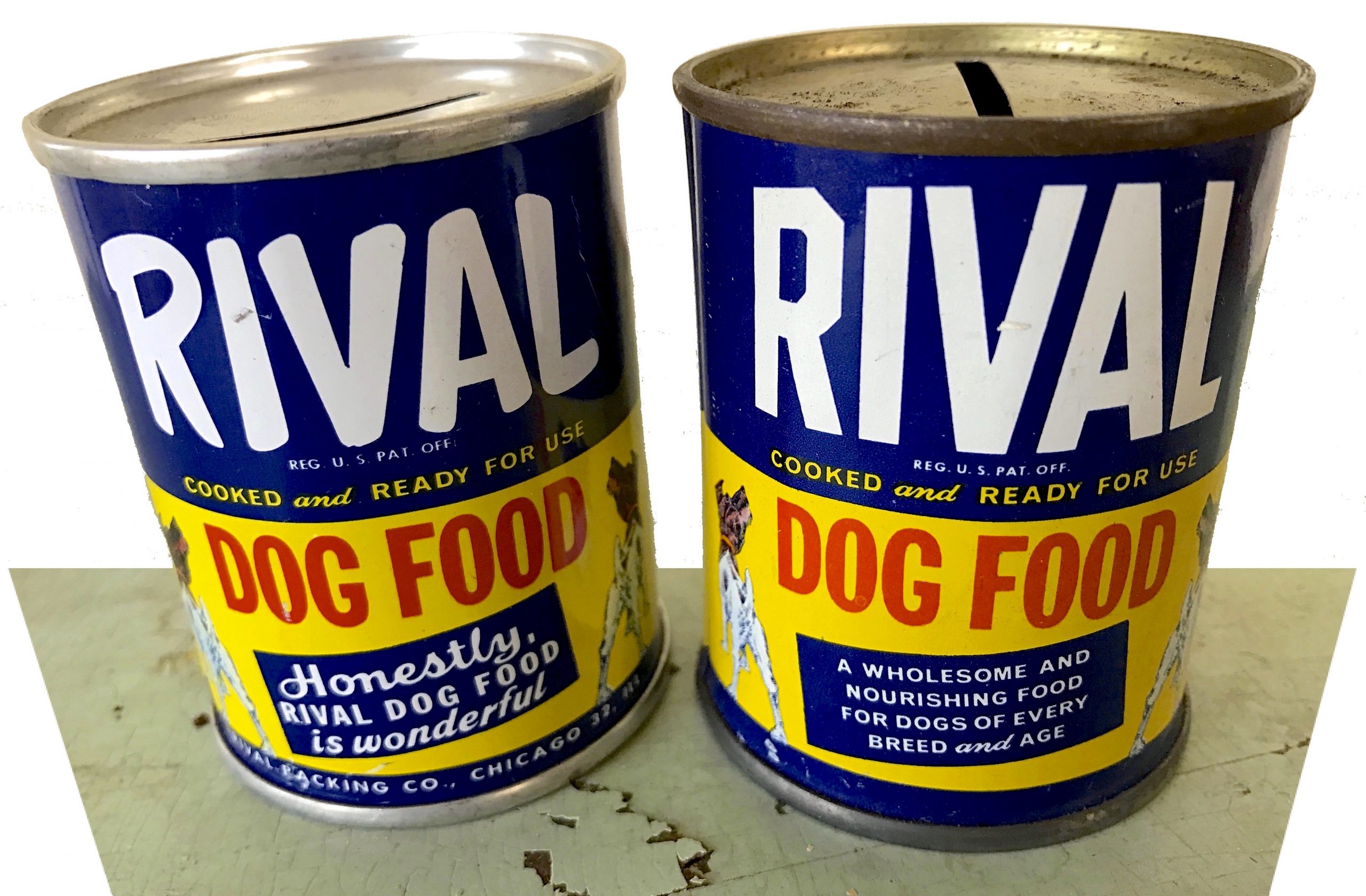
Museum Artifact: Rival Dog Food Coin Banks, 1950s
Made By: Rival Packing Co., 4500 S. Tripp Ave., Chicago, IL [Archer Heights]
[♫ To the tune of Johann Strauss’s “Blue Danube Waltz” ♫]
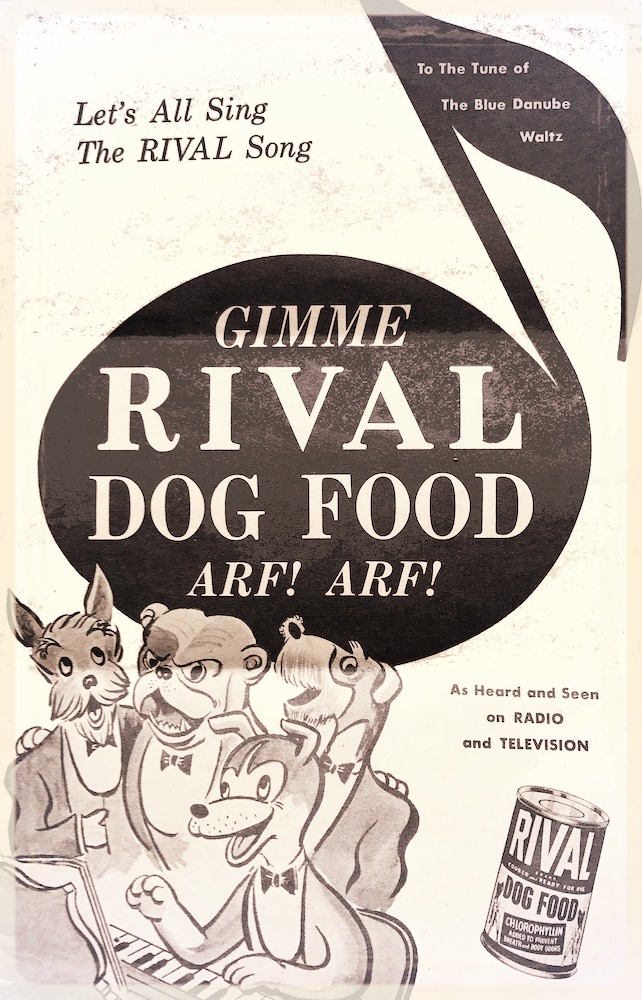 Gimme Ri-val Dog Food, Arf Arf, Arf Arf!
Gimme Ri-val Dog Food, Arf Arf, Arf Arf!
Gimme Ri-val Dog Food, Woof Woof, Woof Woof!
Your Dog’s Eyes Will Shine—Coat Look Fine
On Nourishing Ri-val Dog Food, Arf Arf!
In Ri-val the qua-li-ty’s high—
That makes it your best dog food buy, Arf Arf!
—Rival advertising jingle, 1950s
The modern pet food industry is a very different animal—pardon the pun—than it was back in the early days of the Rival Packing Company. When this upstart Chicago firm started widely promoting its canned dog food in 1932, the majority of Americans were still content to just feed their canines table scraps or sic ‘em on jackrabbits. Variations on the milk bone / dog biscuit had been around for a while, but the notion of giving a mutt a pre-cooked, store-bought, vacuum-sealed meal? That marked a real sea change in the culture—a transition of the dog from “best friend” to family member.
In the midst of the Great Depression, nobody seemed too concerned about where this mysterious new chow came from, either—even if the answer was “an amalgamation of extraneous slaughterhouse run-off,” as was the case with early Rival rivals like Pard (made by Swift & Co.) and Dash (by Armour & Co.). To its credit, Rival was a tad more sophisticated from the outset. Not only did the company purchase its own ingredients and hold its pooch food up to nearly bipedal standards, they also never missed a chance to let everybody know about it.
Commercial jingles and promotional items—like the mini coin banks in our museum collection—were hallmarks of Rival’s far-reaching brand awareness strategy. Never before had a company figured out how to get a can of dog food displayed proudly on its customers’ bedroom nightstands. But the answer was right there all along—remove the dog food, add a coin slot! With many of these old banks still in circulation several generations later, the colorful campaign of a pet food pioneer lives on.
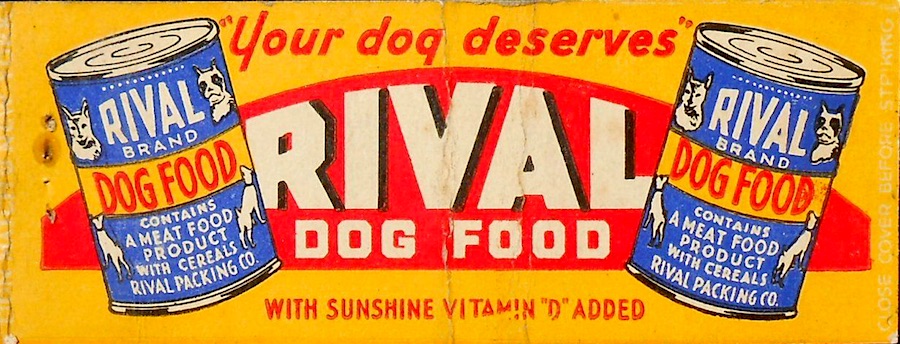
History of Rival Dog Food, Part I: Puppyhood
The Rival Packing Co. was organized in 1923 by William Ruger, Jr., Leo J. Kramer, and C. D. White at 1020 West 36th Street—the same headquarters as the well established Oppenheimer Casing Company. A year later, 46 year-old meat canning mogul Harry D. Oppenheimer was officially listed as Rival’s president.
There is no clear evidence of Rival producing pet food during the 1920s, but it’s possible they were doing so with minimal promotion. Either way, by 1930, the company’s HQ had moved to 322 W. Illinois Street—another address already affiliated with a major cheese and sausage packing operation, the J. S. Hoffman Company. When the founder of that business, Jacob Sidney Hoffman, died that same year at just 47 years of age, it left his younger brother Harry I. Hoffman in charge. This set the stage for the next key development in the Rival story, as Hoffman, Oppenheimer, and a man named Meyer Katz purchased all shares of a revamped Rival Packing Company in 1933 (shortly after the first Rival Dog Food advertisements began appearing in newspapers).
In retrospect, they probably should have renamed the business Katz & Dogs, Inc., but no point crying over spilled meat.
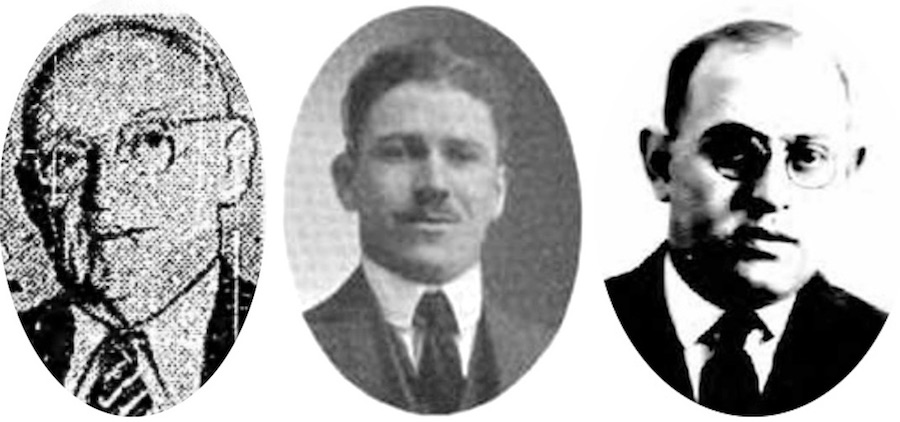 [From left to right, Rival executives Harry Oppenheimer, Harry Hoffman, & Meyer Katz]
[From left to right, Rival executives Harry Oppenheimer, Harry Hoffman, & Meyer Katz]
Meyer Katz, the central architect of the Rival brand, was born in Orange, New Jersey, in 1889—the son of Jewish immigrants from Russia. By the 1910s, he found work with the Acme Packing Company (makers of the Red Crown brand of corned beef and sausages), eventually rising to the level of Sales Manager and later Vice President at the firm’s Chicago office. With Acme, a still thirty-something Katz made connections in the meat packing industry throughout the Midwest and beyond, even taking several sales trips to exotic locales like Cuba and Puerto Rico.
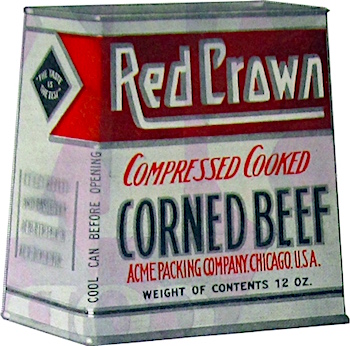 After the business consolidated in 1920, Katz appears to have briefly relocated to Acme’s new headquarters in Green Bay, Wisconsin—where the company had also taken over ownership of a certain local pro football club. The leather-headed Green Bay Packers officially joined the fledgling NFL (then known as the APFA) in the summer of 1921, and by November, Meyer Katz was listed among local boosters raising money to send the team’s marching band to Chicago for a big game against the Cardinals.
After the business consolidated in 1920, Katz appears to have briefly relocated to Acme’s new headquarters in Green Bay, Wisconsin—where the company had also taken over ownership of a certain local pro football club. The leather-headed Green Bay Packers officially joined the fledgling NFL (then known as the APFA) in the summer of 1921, and by November, Meyer Katz was listed among local boosters raising money to send the team’s marching band to Chicago for a big game against the Cardinals.
He didn’t hang around long enough to see the Pack rise to football prominence, however. When the Acme Packing Co. started skidding into financial problems, Katz returned to Chicago himself in 1922, joining the aforementioned J. S. Hoffman Co. as its General Sales Manager. From there, Meyer’s wealth of experience and eventual ties to the two Harrys (Hoffman and Oppenheimer) paved the way for his prime involvement with the Rival Packing Co.
By 1935, with Rival’s early ad campaigns producing some promising returns, a 46 year-old Katz officially replaced Oppenheimer as company president. A year later, Rival relocated from its portion of the Hoffman plant (alternately listed as 501 Orleans Street) to its own exclusive 35,000 sq. ft. facility at 3718 S. Ashland Avenue.
The company was on the rise, but sustained success was far from guaranteed. The brutal economic climate was taking down major factories every day, and in the pet food market, plenty of other meat packing firms had already jumped in the game and established their own brands. To survive, Rival would need to distinguish itself from everything that had come before. To thrive, they would have to anticipate everything that had to come next.
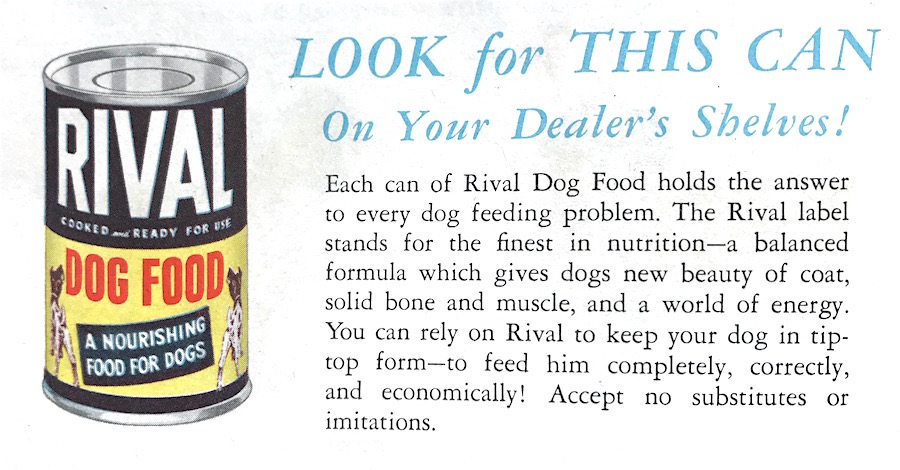
II. Feeding the Four-Legged
Canned dog food, while far from mainstream, had technically been around since the early 1920s, when the Ken-L-Ration company (based in Rockford, Illinois) infamously blazed the trail utilizing an unlikely primary ingredient. . . horse meat. Ken-L-Ration’s president, an Englishman named Philip Chappel, is often credited with launching the modern pet food industry, but he might be better shamed in retrospect as a genocidal killer of mustangs, single-handedly erasing much of the animal’s population out West, and even breeding his own stock of horses for years—exclusively for dog feeding purposes.
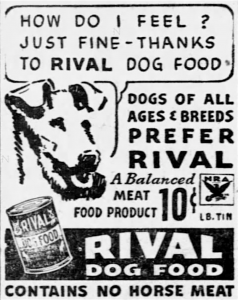 Horse meat was still very much associated with pet foods into the 1930s—a connection Rival sought to squash from day one, splashing “Contains No Horse Meat” on most of its early advertisements [the newspaper ad here is from 1934]. That distinction really could have gone even further.
Horse meat was still very much associated with pet foods into the 1930s—a connection Rival sought to squash from day one, splashing “Contains No Horse Meat” on most of its early advertisements [the newspaper ad here is from 1934]. That distinction really could have gone even further.
“The Rival Dog Food Company of Chicago never actually slaughtered an animal,” researcher Katherine C. Grier notes in her article Provisioning Man’s Best Friend: The Early Years of the American Pet Food Industry: 1870-1942. “Rather, it contracted for meat, probably ‘canner’ quality beef.”
Basically, by buying up a specific standard of grade-B beef parts from third party slaughterhouses, Rival could confidently test and perfect its formulas (adding simple ingredients like wheat, oats, barley, soya flour, etc.) without having to worry about managing its own beasts in the stockyards. The challenge, early on, was just convincing merchants and animal owners that a 10-cent can of Rival pet food—or any pet food, for that matter—was a worthwhile investment.
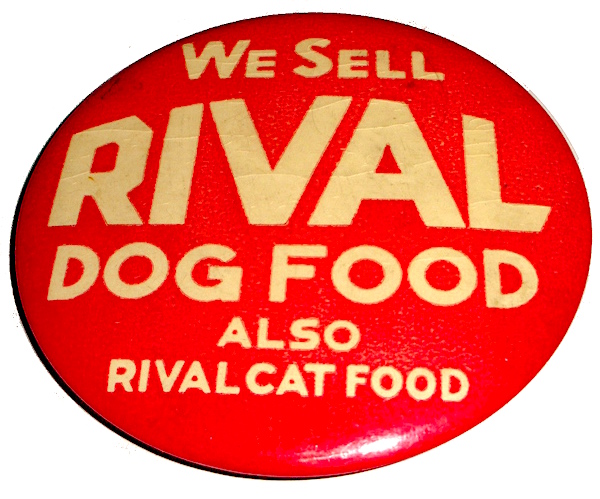 “The grocer was apprehensive—he wondered whether there was a market for it,” remembered a former Rival sales executive named Harry Gadau, quoted in a 1967 newspaper interview. “’Dog food?’ they would say. ‘I sell groceries in my store.’”
“The grocer was apprehensive—he wondered whether there was a market for it,” remembered a former Rival sales executive named Harry Gadau, quoted in a 1967 newspaper interview. “’Dog food?’ they would say. ‘I sell groceries in my store.’”
Gadau joined the Rival Packing Co. in 1927 and spent fifty years climbing the corporate ladder. But he never forgot his early struggles in selling his product to an unindoctrinated public. Besides store owners, there were obstacles with the main grocery buyers, as well—the American housewife.
“She was skeptical whether dog food was good enough for her pet,” Gadau said. “I bet we didn’t spend much more than $50,000 for advertising pet foods the first year . . . But as more brands were introduced, the multiplicity of advertising created an awareness among consumers.”
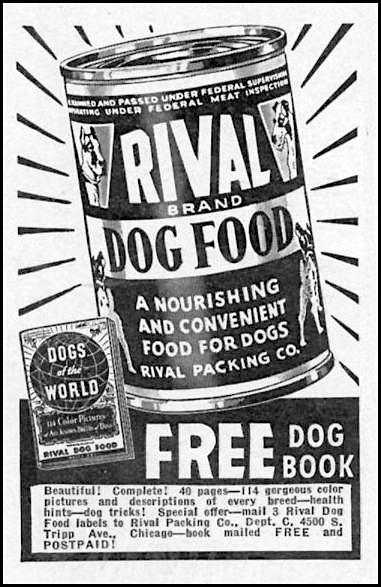 Not everyone saw that public awareness as a good thing. As pet food profits soared in contrast with the 1930s economy, rumors spread that some unfortunate people—left desperate by the Depression—were now resorting to eating dog food for their own meals. This raised new questions about the actual ingredients and potential health risks of canned dog food, and brought criticism in the direction of companies like Rival, which had sometimes promoted their products as being up to human standards.
Not everyone saw that public awareness as a good thing. As pet food profits soared in contrast with the 1930s economy, rumors spread that some unfortunate people—left desperate by the Depression—were now resorting to eating dog food for their own meals. This raised new questions about the actual ingredients and potential health risks of canned dog food, and brought criticism in the direction of companies like Rival, which had sometimes promoted their products as being up to human standards.
Meyer Katz was forced to defend himself, telling the National Provisioner, “The product is labeled ‘fit for human consumption’ to prove to the dog owner that it is pure. . . . There is no reason for humans to eat dog food since many more suitable foods are cheaper.”
More suitable, sure. But would they make their eyes shine and coat look fine?
III. The Scientific Method
By the late 1930s into the early ‘40s, magazines like the Consumers’ Research Bulletin started diving into the subject of pet food safety, releasing scathing reviews of the entire industry, noting a total lack of regulation from the Food and Drug Administration. “It is understood that no money is being spent by the FDA on the control of the quality of dog food,” one report bluntly stated, adding that canned dog food could not be recommended for regular use until major changes occurred.
Switching from defense to offense, Katz and his team seemed to address these issues by framing Rival as a beacon of quality within an otherwise hazy marketplace—a trusty sheriff in the Wild West. This pet food was government tested, nutritious, “scientifically formulated,” and still, of course, reasonably priced. Rather than running away from issues of health and safety, Rival invited consumers to look at pet food as a serious purchase worthy of careful consideration.
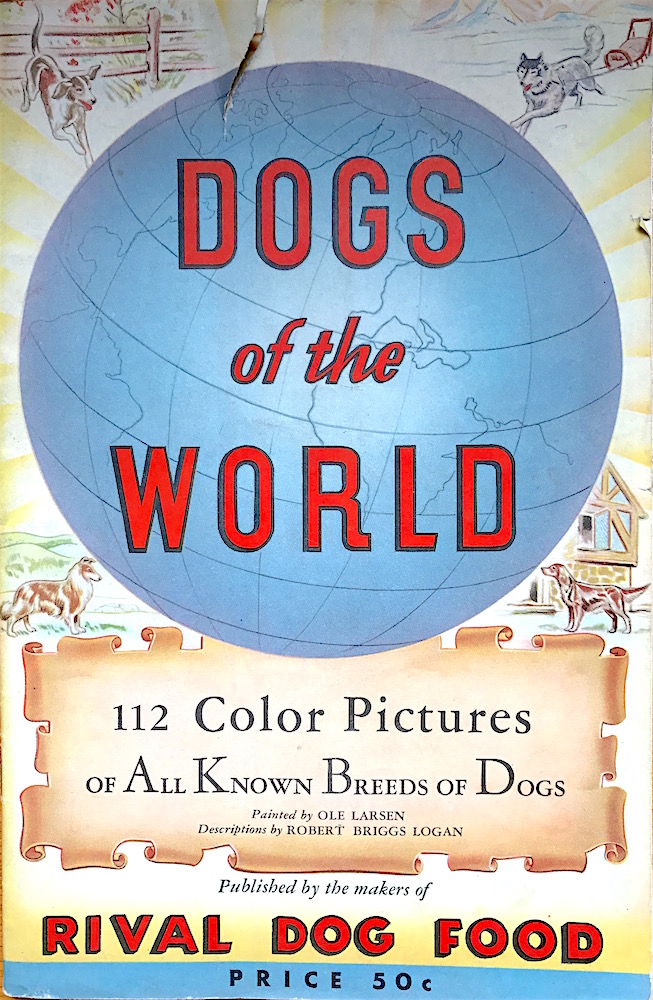 “We say proudly and emphatically—that Rival builds healthy dogs at a low cost,” reads a page inside the company’s 1940 educational guidebook / giant advertisement, Dogs of the World. “Rival does all you want a dog food to do, surely and economically.
“We say proudly and emphatically—that Rival builds healthy dogs at a low cost,” reads a page inside the company’s 1940 educational guidebook / giant advertisement, Dogs of the World. “Rival does all you want a dog food to do, surely and economically.
“Make no mistake—Rival contains plenty of meat. But Rival’s meat content has been enhanced in feeding effectiveness by choice grains, rich in body-building, energy-maintaining food elements, precious natural vitamins and minerals. It simply is not necessary to add a single thing to a dog’s diet if he is fed Rival. Yes, Rival alone will keep him in tip-top condition!
“Rival blends meat and other ingredients scientifically—under strict laboratory control—and conducts year-round feeding tests in its own kennels to prove results. The makers of Rival devote all their time, facilities and resources to the canning of Rival Dog Food, with the single purpose of feeding your dog correctly!”
There’s certainly no doubt that Rival put plenty of science into its dog food production, it’s just hard to determine whether the calculations were motivated more by the health benefits or factory efficiency.
Either way, the company successfully established a positive reputation, and enjoyed the profitable perks that came with it. By 1940, after five years in the relatively small Ashland Avenue plant, Rival moved into a new $400,000 headquarters in the Crawford Industrial Park within the Central Manufacturing District—at the corner of Tripp Avenue and W. 45th Street. The state-of-the-art, three-story facility offered year-round air conditioning and 85,000 sq. ft. of factory space, with advanced freezer rooms (basement), a shipping-and-receiving department (first floor), an ad department and employee cafeteria (second floor), and expansive machining rooms (top floor). President Katz also had his own new swank office to preside over one of Chicago’s true up-and-coming businesses.
 [The former Rival Packing Co. plant is still standing at Tripp Ave. and 45th St., most recently in use as a rental space for rock bands]
[The former Rival Packing Co. plant is still standing at Tripp Ave. and 45th St., most recently in use as a rental space for rock bands]
IV. The Story of a Trip through the plant that makes Rival Dog Food
Provided below in its entirety (and with editorial commentary from your friendly Made In Chicago curator) is a long-form advertisement that originally appeared in Rival’s Dogs of the World promotional book in 1940. It’s a fictional account of a dad and son visiting the brand new Rival Packing Co. plant on Tripp Avenue. It’s awful, but potentially amusing AND educational.
“Come on, Dad!” said little Bobby Brown to his father. “Let’s GO!” Bobby was excited. This was the day that he and his dad were to visit the great Rival Dog Food plant on Chicago’s Southwest side. It would be a real adventure for young Bobby to see just how the favorite food of his dog, Skipper, was manufactured. [editor’s note: Skipper is the name of the dog, not the food, despite the confusing structure of that sentence]
“Just look at that great big building,” cried Bobby.
Dad smiled. “Yes, son, and it’s devoted entirely to the canning of Rival Dog Food.”
“And all those windows,” said Bobby. “I guess they let in plenty of sunlight.” [editor’s note: Bobby is not going to become less annoying, so dig your heels in]
 [Here’s what Bobby and his dad would see if they went back to the former Rival plant today (images courtesy of The Rock Spot and John Sigerson]
[Here’s what Bobby and his dad would see if they went back to the former Rival plant today (images courtesy of The Rock Spot and John Sigerson]
The door opened, and Bobby and his dad were greeted by the Plant Superintendent. “Glad to see you, Mr. Brown—and Bobby,” he smiled. “It’s nice to have you folks here, so that we can show you just how much care we take to make Rival the very finest food any dog can eat.”
“Well, Skipper certainly loves his Rival Dog Food! He never leaves a bit of it in his dish—and he’s the best looking dog on our block!”
“Thank you, Bobby. And now, let’s go inside,” said the superintendent [editor’s note: Bobby said his dog was good looking and the superintendent responded by saying ‘thank you.’ Odd.]. “First, I want you to notice the CLEANLINESS of our plant.”
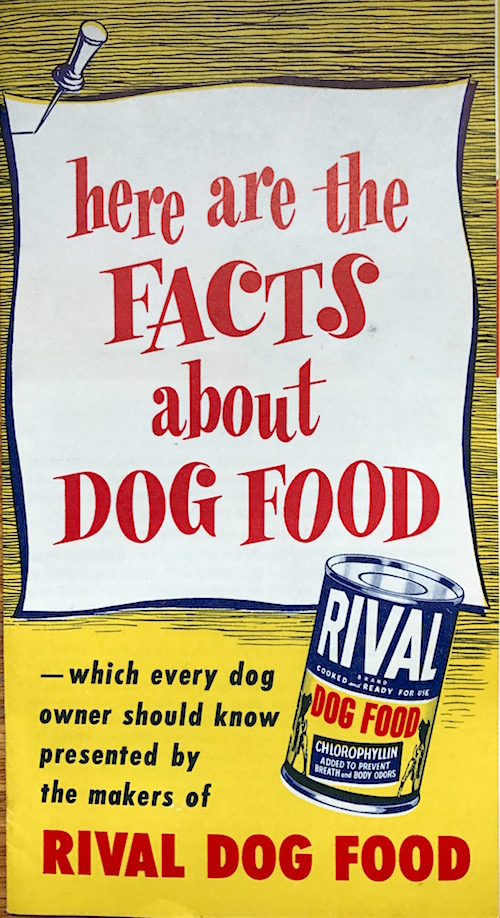 Bobby looked around. “Golly! Everything looks just as clean as Mom’s own kitchen!”
Bobby looked around. “Golly! Everything looks just as clean as Mom’s own kitchen!”
“Thank you, Bobby. We take a lot of pride in our cleanliness and sanitation. Notice these walls—every square inch of every wall in the plant is washable tile, and I’m sure your mother, like every housewife, knows how easy it is to keep tile walls clean. [editor’s note: “Why do you just presume my mama is a housewife? Is it 1940 or something?”] The windows have round corners and ledges—no sharp angles to catch dust. And at the end of each working period, the walls, floors, machines, cooking utensils—everything is washed with scalding hot water and live steam.”
“You’ve certainly given us convincing proof of cleanliness, Mr. Superintendent,” said Bob’s dad [cutting the tension with a knife]. What’s behind these doors?”
“They lead into our giant meat refrigerators. Let me show you what’s inside.”
The superintendent swung the doors open. “Golly!” exclaimed Bobby—“I never saw so much meat in my life!”
The superintendent laughed. “No, I don’t suppose you have, Bobby [creepy]. There are over a million pounds of meat and meat-by-products in here at all times.”
“How do you use this meat?” asked Mr. Brown [suspiciously].
“Well, Mr. Brown, first the meat goes to the chopping machines. Then it is weighed to assure the right proportions according to the exclusive Rival formula. After that, it goes to the mixing machines where it is scientifically combined with choice grains and other nourishing ingredients.”
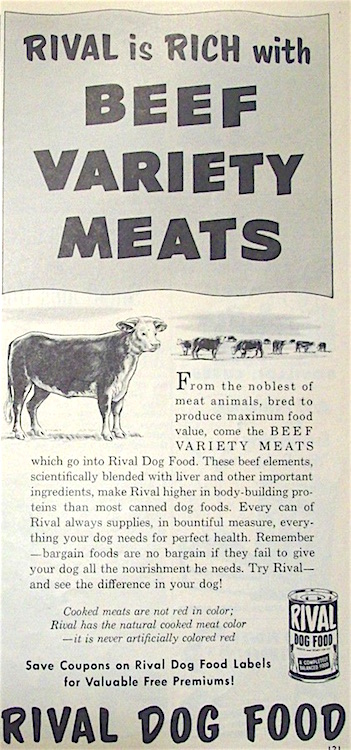 “What’s a formula?” asked Bobby. [ugh, how old is this kid anyway?]
“What’s a formula?” asked Bobby. [ugh, how old is this kid anyway?]
“It’s like a recipe,” explained the superintendent. “Rival is made by a recipe, just like your Mother prepares meals from her recipes.” [“You’re seriously talking about my mama again?!”]
“What are those big machines?” asked Bobby.
“Those,” said the superintendent, “are meat choppers and mixers. Let me show you these marvels of mechanical ingenuity! [aaahhh, my arm!] The meat and meat-by-products, fresh from the refrigerators, the cereals and other ingredients go into these choppers and mixers without once being touched by human hands! Giant spiral steel arms churn all the ingredients into a thoroughly mixed blend of nourishing food elements which keep a dog healthy and happy! Finally, the food is ready to be placed into the cans.”
“And there are the cans, Bobby,” said his dad. “Just look at that endless stream of gleaming cans traveling up from the floor below on conveyors.” [Kinda makes you ponder the pointless march that is existence, doesn’t it, Bobby?]
“They look so clean and shiny!” said Bobby.
“Yes, they are—but Rival takes extra precautions,” said the superintendent. “Just before the cans reach the filling machines, they pass through a cloud of live steam and hot water in the sterilizer which makes them scientifically and absolutely sterile! And now, the mixed food is put into the sterilized cans by the high speed filling machines.”
“You mean the cans go into those filling machines empty—and come out filled with Rival Dog Food?” asked Bobby.
“Yes—each can will be filled with exactly one full pound of Rival. The cans are filled with Rival Dog Food, the air exhausted, and the can vacuum sealed—with the purity, wholesomeness and flavor of its contents completely guarded.” [“We’ll see about that,” Bobby whispered villainously]
“Those machines work so fast you almost can’t see what they’re doing!” said Bobby. “Now are the cans ready to be sent to the store so folks can buy them?”
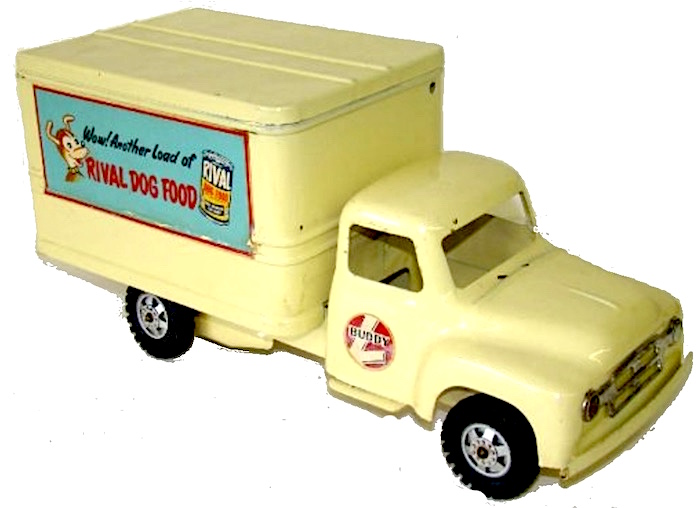 “I should say not!” said the superintendent. “First, every can is washed on the outside with hot water—because the cans must sparkle outwardly as well as inwardly—the Rival folks are strong for CLEANLINESS!” [That capitalization is straight from the original article. The superintendent is shouting the word “cleanliness” into little Bobby’s face].
“I should say not!” said the superintendent. “First, every can is washed on the outside with hot water—because the cans must sparkle outwardly as well as inwardly—the Rival folks are strong for CLEANLINESS!” [That capitalization is straight from the original article. The superintendent is shouting the word “cleanliness” into little Bobby’s face].
“What are those big metal tanks?”
“We call them retorts or cookers—each one holds 2,000 cans of Rival Dog Food at one time. In these cookers, each can of Rival is cooked at a specific temperature and steam pressure. That means when Rival reaches you, it is fully cooked and ready to serve to your dog. Now watch this, Bobby,” continued the superintendent [who shall apparently remain permanently unnamed]. “At the proper time, the door of the retort swings open, and the cans roll down a track into a cold-water shower.”
“A shower!” said Bobby in surprise [he had been told this would be nothing like gym class].
“That’s right. You see, the cooking in the retorts makes the cans very hot, and this cold shower cools them off, so that they are ready to be labeled.”
“It’s almost a miracle, Mr. Superintendent,” said Bobby’s father. “All these thousands of cans of Rival Dog Food ready to be labeled, and not a single human hand has touched any of the ingredients.”
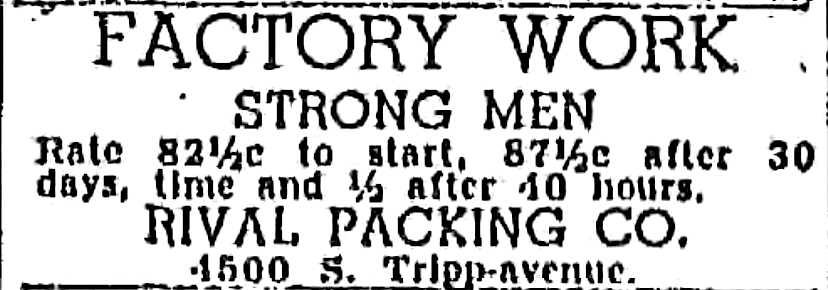
[“Yes, the replacement of human labor with automation truly is miraculous and great in all ways”] “I want you to watch the labeling of the cans,” said the superintendent. “The cans come down the conveyors at a great speed—to another wonder of this mechanical age—automatic labeling and carton filling machines! Each can is quickly encircled with the colorful and familiar Rival Dog Food label, and 4 rows of 12 cans each are neatly packed into the shipping cases—just the way they are received by your dealer! And before they go into the cases, they are given one more inspection to make sure that each can is perfect.”
“I imagine you do quite a bit of testing here,” said Bob’s father.
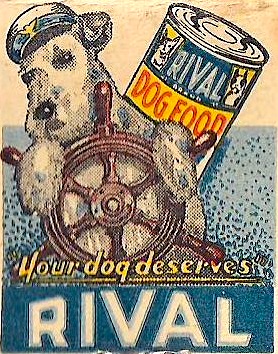 [“Yup, strict rules. Gotta pee into a cup once a month,” said the superintendent forlornly]. “Yes, we make sure that every can of Rival Dog Food can be depended upon for purity, wholesomeness and nourishment. First, our own laboratories, right in this plant, double-check each ingredient before it is used. Then, each batch of the mixed product, identified by a control number, is tested again. Every hour, finished cans are opened and examined to make sure Rival is consistent in color, texture, and conforms exactly to the Rival formula. But that’s not all. Rival maintains its own kennels, where dogs are fed year-round on Rival and Rival alone. Those dogs give us final and conclusive proof that Rival Dog Food will keep any dog in tip-top condition, with lively, dancing eyes and sleek, silky coat.”
[“Yup, strict rules. Gotta pee into a cup once a month,” said the superintendent forlornly]. “Yes, we make sure that every can of Rival Dog Food can be depended upon for purity, wholesomeness and nourishment. First, our own laboratories, right in this plant, double-check each ingredient before it is used. Then, each batch of the mixed product, identified by a control number, is tested again. Every hour, finished cans are opened and examined to make sure Rival is consistent in color, texture, and conforms exactly to the Rival formula. But that’s not all. Rival maintains its own kennels, where dogs are fed year-round on Rival and Rival alone. Those dogs give us final and conclusive proof that Rival Dog Food will keep any dog in tip-top condition, with lively, dancing eyes and sleek, silky coat.”
“Thank you, Mr. Superintendent!” said Bobby [quickly erasing any thoughts of captive, taste-testing dog slaves living in the factory basement]. “I’m certainly glad I made this visit to your plant. I’m going to tell Mamma that Rival Dog Food is made in the CLEANEST place I’ve ever seen—and I’m going to tell Skipper that now I know why Rival keeps him looking and feeling like a million dollars!” [No, Bobby. You know how Rival keeps Skipper looking like a million dollars. You will never know WHY!]
V. Dogs of War
In stark contrast to the idyllic faux reality of little Bobby’s magical tour through Willy Wonka’s puppy chow plant, America was about to go to war again, and no business would be able to carry on exactly as it had prior.
In the years right before World War II, canned dog food dominated the market, with 90% of all pet food sales going to products of Rival’s ilk. The war ended that era virtually overnight, however, as many major companies were forced into government service. Canned dog food was not deemed a public necessity, and Rival was instructed to discontinue its production in favor of war rationing for the soldiers overseas.
Fortunately, like so many other Chicago manufacturers, Rival took to the new effort with pride, producing C-rations for the Army—a fighting force which included Meyer Katz’s own son. The company was also able to use some of the money from its government contract to keep their regular ad campaigns going during the war years, wisely keeping themselves in the public consciousness even while their famous product was on hiatus.
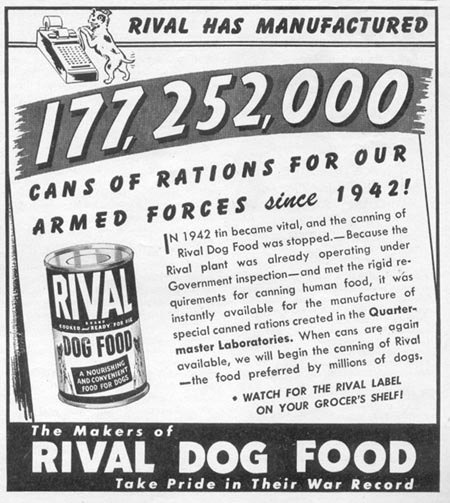 “Rival Has Manufactured 177,252,000 Cans of Rations for our Armed Forces since 1942!” read one advertisement in 1945. “In 1942 tin became vital, and the canning of Rival Dog Food was stopped. —Because the Rival plant was already operating under Government inspection—and met the rigid requirements for canning human food, it was instantly available for the manufacture of special canned rations created in the Quartermaster Laboratories. When cans are again available, we will begin the canning of Rival—the food preferred by millions of dogs. Watch for the Rival Label On Your Grocer’s Shelf!”
“Rival Has Manufactured 177,252,000 Cans of Rations for our Armed Forces since 1942!” read one advertisement in 1945. “In 1942 tin became vital, and the canning of Rival Dog Food was stopped. —Because the Rival plant was already operating under Government inspection—and met the rigid requirements for canning human food, it was instantly available for the manufacture of special canned rations created in the Quartermaster Laboratories. When cans are again available, we will begin the canning of Rival—the food preferred by millions of dogs. Watch for the Rival Label On Your Grocer’s Shelf!”
As it turned out, Rival’s biggest challenges actually awaited them after the war was over, when the attempt to pick up where they’d left off was quickly threatened by the emergence of “the kibble era”—dried dog food that lasted longer, cost less, and seemed to please the pooches just as well.
In 1947, the Commerce Department also threatened bringing back major restrictions on the use of tin cans by dog food manufacturers, claiming the resource could be better saved and utilized for more pressing needs. Opponents argued that pet owners would respond by buying more human food and feeding it to their pets, thus hurting the government’s larger goal of food conservation. Meyer Katz was more direct, telling the Tribune that any such restriction “would put us and others in the same field out of business completely.” The rules didn’t go into place, but it was clear that things would not be returning to business as usual for the now 58 year-old Katz.
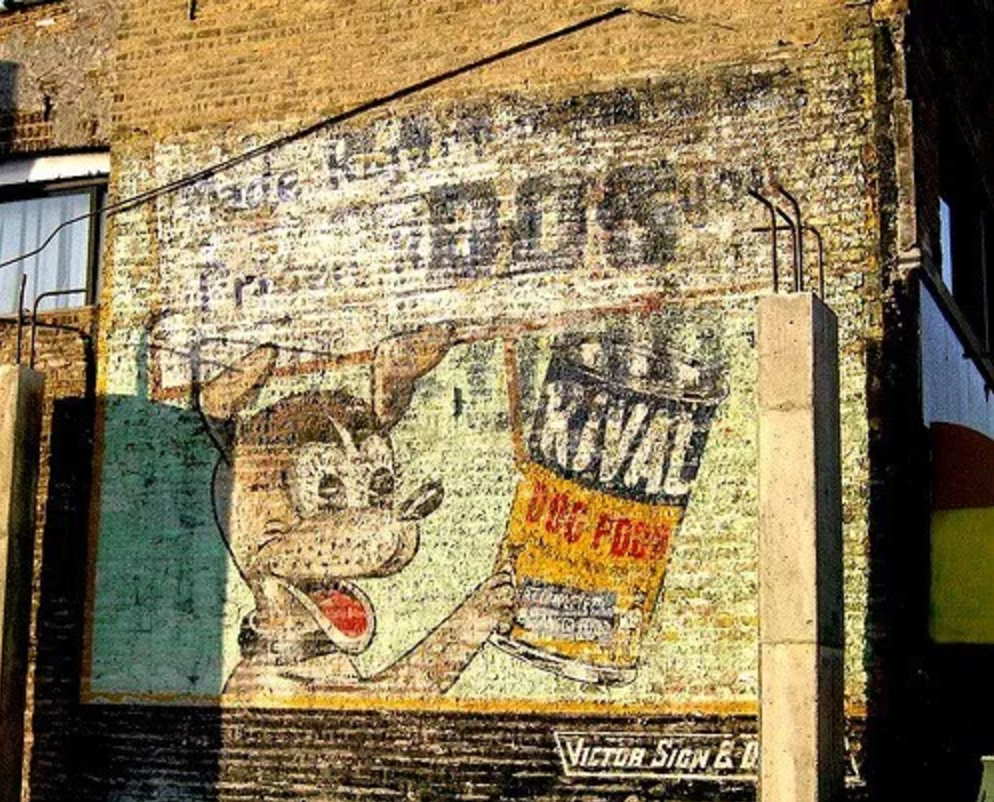 [Until recently, this vintage Rival ad was still visible on a building at 6224 N. California Ave.]
[Until recently, this vintage Rival ad was still visible on a building at 6224 N. California Ave.]
VI: Ear Worms
Before the war, Rival had relatively few rivals able to match their marketing efforts. By the the dawning of the 1950s, however, they were struggling to fend off increasingly powerful challengers in both the canned and dry food categories. America’s exploding demand for pet food meant that just about everybody still had money to be made. The hard part was “holding the line”—maintaining one’s share of the market.
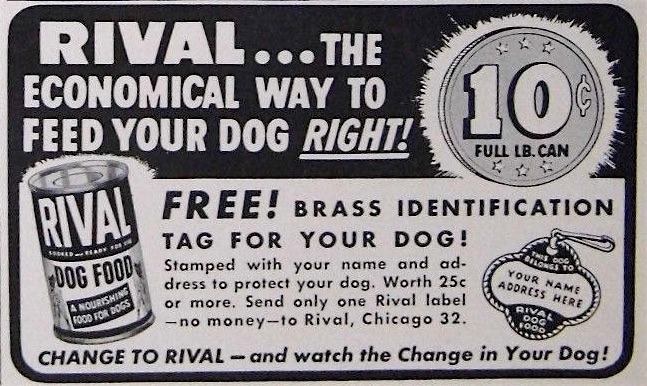 Accordingly, Rival started promoting itself as doing just that—”holding the line”— by keeping its price at a firm 10 cents per 1 LB can. They ran newspaper ads in 1950 dressed up as press releases:
Accordingly, Rival started promoting itself as doing just that—”holding the line”— by keeping its price at a firm 10 cents per 1 LB can. They ran newspaper ads in 1950 dressed up as press releases:
“CHICAGO, November 13, 1950—Housewives can’t buy much with a dime today, but when it comes to Rival Dog Food, the little ten cent piece still looks like its old self. The makers of Rival are holding the line on price, in spite of the fact that all the elements that go into its manufacture have increased in cost. Since dog food is an important item with millions of dog owners, it is no wonder that so many have expressed their appreciation to the Rival Packing Company for maintaining its 10 cent price for the full pound can, by buying in ever increasing quantities.”
The use of special promotions increased, too—from the official sponsorship of a Rival Dog Food softball team to special free give-aways of brass identification tags for dog collars. There were also Rival toy delivery trucks and, of course, those awesome coin banks. On TV and radio, the Rival Dog Food jingle began worming its way into the brains of unsuspecting men and women, exploiting the genius of Johann Strauss to sell cylinders of meat to animals: “Gimme Rival Dog Food. Arf Arf.” The song was sung, incidentally, not by cartoon dogs, but by the velvety voiced Skip Farrell, with “arf arfs” performed by radio actor Paul Barnes.
[A promotional recording made by Rival in 1951/52, featuring the Rival Dog Food song + some added commentary from sales manager Art Aldag. Courtesy of the Stanley Katz family]
In 1954, someone at Rival calculated the company must have produced something like a billion cans of dog food by now, and an official promotion was somehow made out of that, as well, touting that Rival had sold “enough cans to circle the earth 2-1/2 times.”
A Des Plaines girl named LaVerne Muuss was even crowned “Miss Billionth Can” as part of the media blitz. You can see her below posing for photos with a 68 year-old Meyer Katz at a press conference, helping him cut a “Billionth Can-iversary” cake. If you’re still out there, LaVerne, let us know how you’re doing.
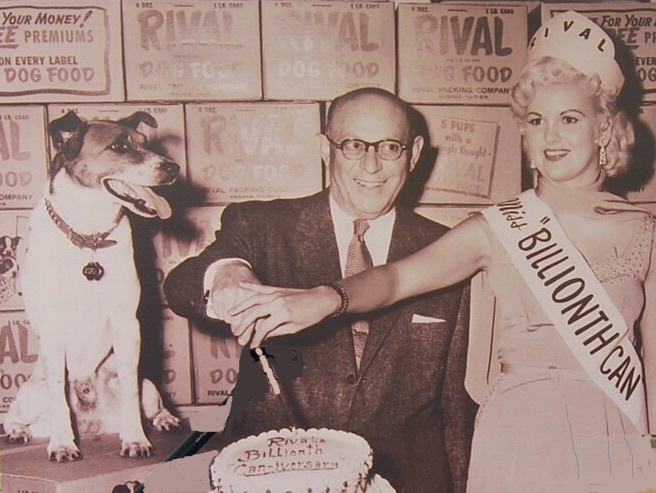 [from left: A pooch, Meyer Katz, and “Miss Billonth Can” LaVerne Muuss, 1954 – courtesy of Stanley M. Katz Family]
[from left: A pooch, Meyer Katz, and “Miss Billonth Can” LaVerne Muuss, 1954 – courtesy of Stanley M. Katz Family]
VII: Katz and Dogs
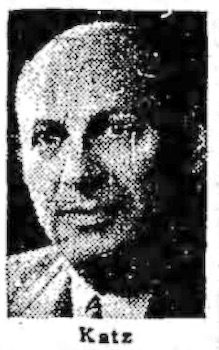 The Billionth Can party was something of a last hurrah for Katz and the independent Rival Packing Company. In 1956, just before his death at the age of 67, Katz elected to sell the business to Associated Products, Inc., a branch of the Consolidated Foods Corp. (the future Sara Lee Corp.). Harry Oppenheimer, who had remained a Rival board member over the years, had died several years prior, and longtime treasurer Harry Hoffman was over 60 himself. The old guard was standing down.
The Billionth Can party was something of a last hurrah for Katz and the independent Rival Packing Company. In 1956, just before his death at the age of 67, Katz elected to sell the business to Associated Products, Inc., a branch of the Consolidated Foods Corp. (the future Sara Lee Corp.). Harry Oppenheimer, who had remained a Rival board member over the years, had died several years prior, and longtime treasurer Harry Hoffman was over 60 himself. The old guard was standing down.
Meyer Katz would be remembered locally for sharing his good fortune quite liberally with those around him. He was a family man and a major contributor to local Jewish charities and medical organizations. He also played no small role in the development of the modern pet food industry as we know it today.
Unfortunately, Katz’s company never quite rediscovered its former heights under its new ownership. The original business was officially dissolved in December of 1957, and Rival subsequently transitioned into “Rival Pet Foods,” a division of Associated Products. The Chicago plant remained in operation, but most major corporate decisions were outsourced, and outside ad agencies handled promotions.
New bosses Morris L. Levinson (Associated Products president) and Nathan Cummings (Consolidated Foods Chairman) tried to keep pace with the likes of Ralston Purina, but they may have had too many plates spinning in their other enterprises to commit the full amount of time and investment required. Morris Levinson ran the Rival division himself for a while in the late 1950s, but was soon followed by Joseph V. Getlin at the head of the department. Getlin, in turn, became the unfortunate poster boy for Rival Dog Food’s slow decline in the 1960s.
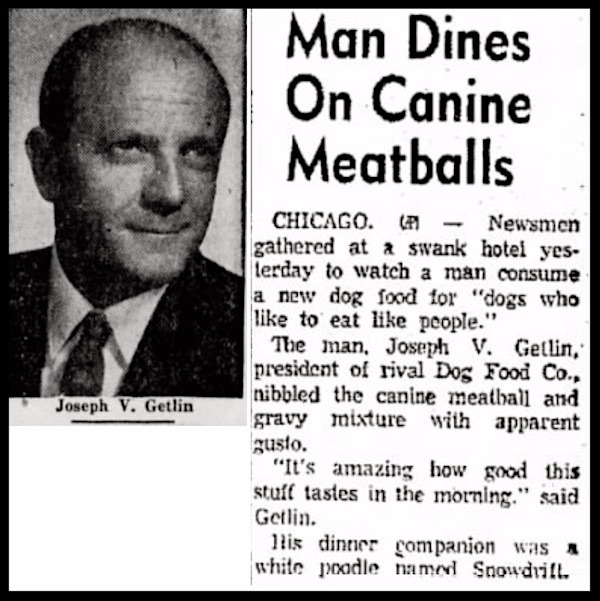 In 1962, keeping with the spirit of the Katz era, Rival held a press conference in which it would introduce its new “meatballs for dogs” by having a trained poodle named Snowdrift eat the delights right there at the podium in a swank hotel ballroom. Unfortunately, Snowdrift was not inspired by the dish presented to him/her, and Joseph Getlin was left in a predicament. Like any good corporate exec, he lowered himself to the occasion, taking a bite of a meatball himself, then proclaiming, “It’s amazing how good this stuff tastes in the morning.”
In 1962, keeping with the spirit of the Katz era, Rival held a press conference in which it would introduce its new “meatballs for dogs” by having a trained poodle named Snowdrift eat the delights right there at the podium in a swank hotel ballroom. Unfortunately, Snowdrift was not inspired by the dish presented to him/her, and Joseph Getlin was left in a predicament. Like any good corporate exec, he lowered himself to the occasion, taking a bite of a meatball himself, then proclaiming, “It’s amazing how good this stuff tastes in the morning.”
Other men would take their shots at jumpstarting the old brand included William C. Durkee, Michael Matthews, and eventually an elderly Harry Gadau, who finally ascended to the head of Rival Pet Foods in 1973—his 46th year with the business (he’d retire a year later). Nobody had the magic solution. That said, nobody was panicking either. In the early ’70s, Associated Products even unveiled a massive new headquarters for Rival, keeping the business in Chicago at 7830 W. 71st Street in Bridgeview. A high-profile ad campaign featuring Snoopy the Dog (of Peanuts fame) was also launched, indicating an ongoing faith in the brand’s broad appeal.
Sometimes, though, doing all the right things can’t prevent the inevitable.
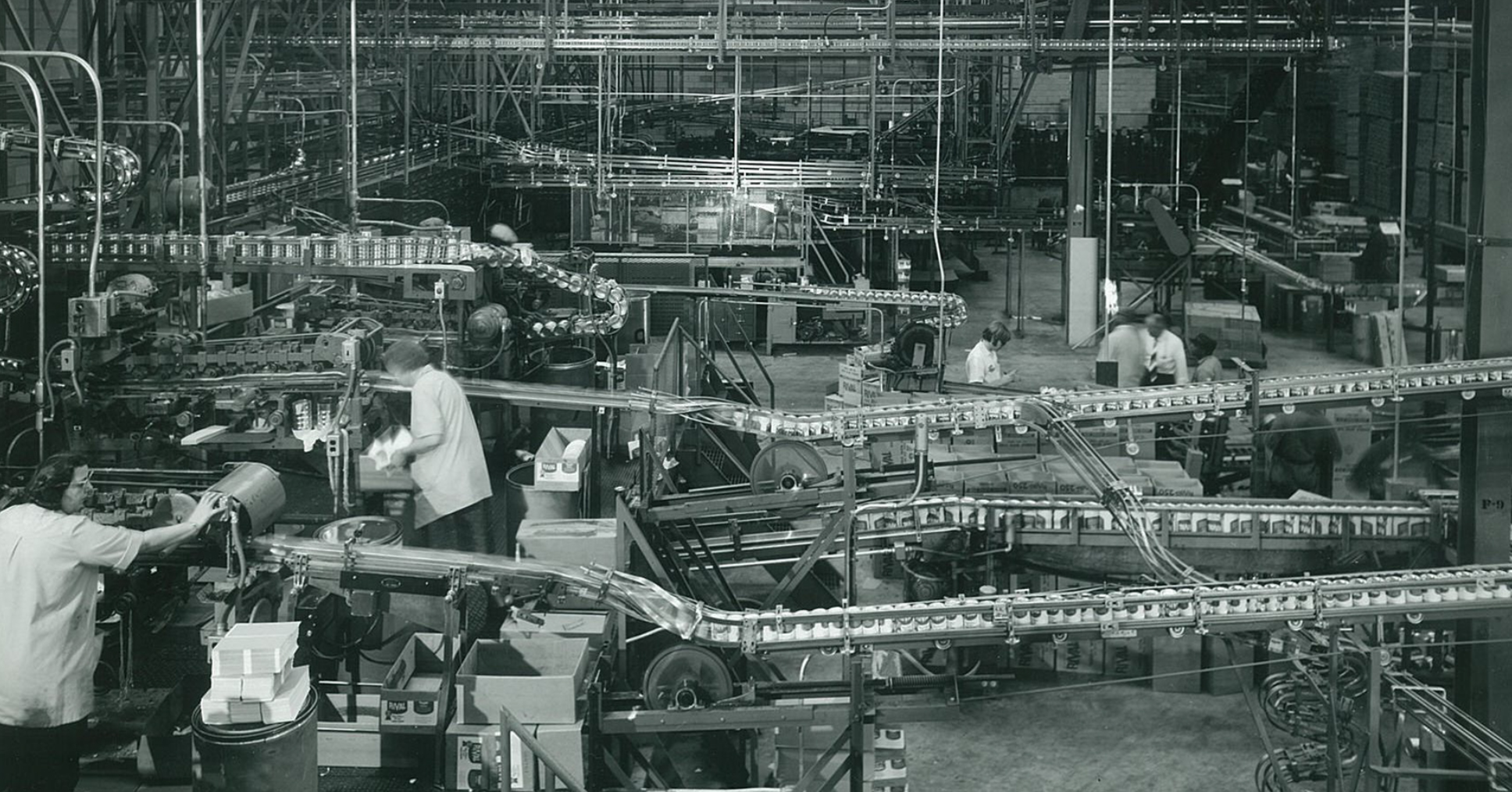 [Workers at the expansive new 71st Street Rival plant, c. 1973]
[Workers at the expansive new 71st Street Rival plant, c. 1973]
According to a vague account in James Shannon’s book Sales Tales, a “recent Harvard MBA graduate” was brought in during the ’70s as the new Rival “CEO,” a hire aimed at shaking things up in the struggling pet food division. The Harvard man set extremely lofty goals, hoping to double Rival’s share of the Chicago market from 11 percent to 22 percent in one year. Toward this effort, he presented a series of perks and motivators for Rival employees and upgraded the factory equipment. When the numbers proved disappointingly flat a year later, the man was beside himself.
“Didn’t I put you salesmen in Buicks?” he supposedly yelped. “Didn’t I double your bonuses? Didn’t we hire a new advertising agency and double the advertising budget? Didn’t we completely revamp and overhaul the manufacturing facilities? Didn’t we completely redo the offices and put a new front on the building? Didn’t we win a packaging award? We still have 11 percent of the market, as much as we had when all this started. All this! What the hell is wrong?!”
According to this particular story, a voice from the back of the room then said softly, “The dogs won’t eat the damn food.”
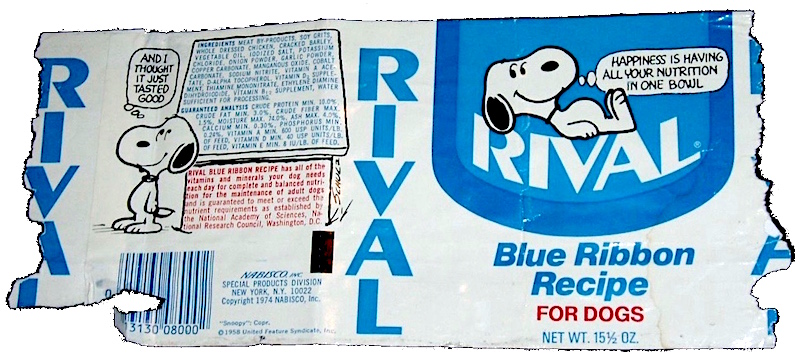
It was Snowdrift all over again.
When Nabisco bought Associated Products in 1973, the countdown clock to doomsday was officially switched on. Rival’s sales had totaled $25 million that year, but Nabisco was basically there to absorb what resources it could before gutting the operation. All Chicago manufacturing ended in 1978, and the Rival name was sold to Strongheart Products that same year, essentially concluding the adventure a little over 50 years after it had begun.
No can dog alive today can remember what Rival Dog Food tasted like. And hopefully no human can either. But many still remember that jingle, so much so that they can’t hear the “Blue Danube Waltz” without adding the arf arfs.
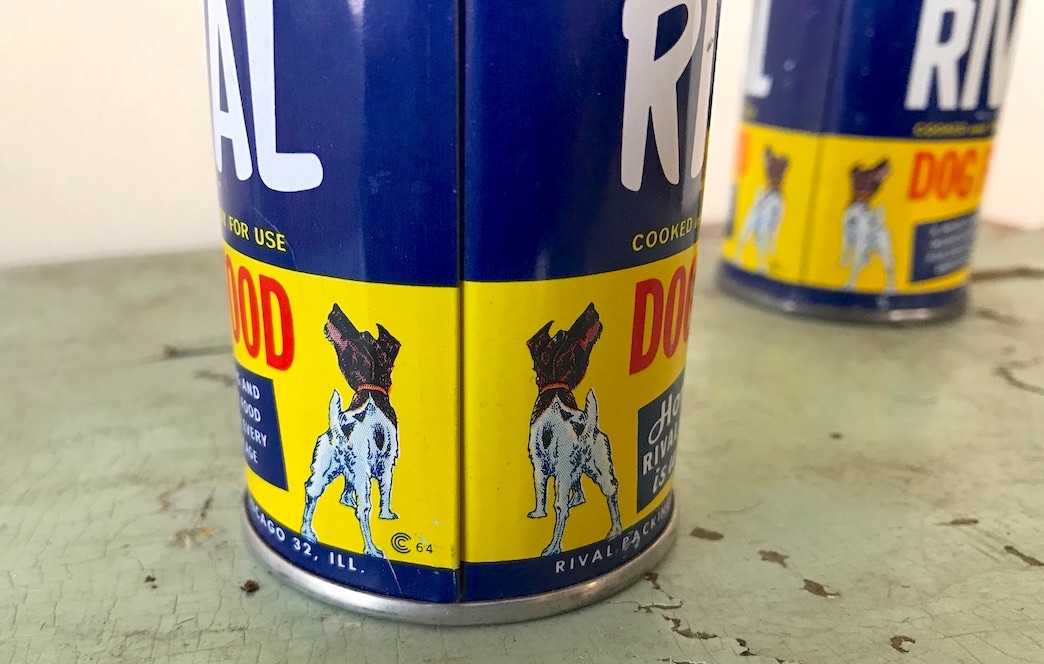
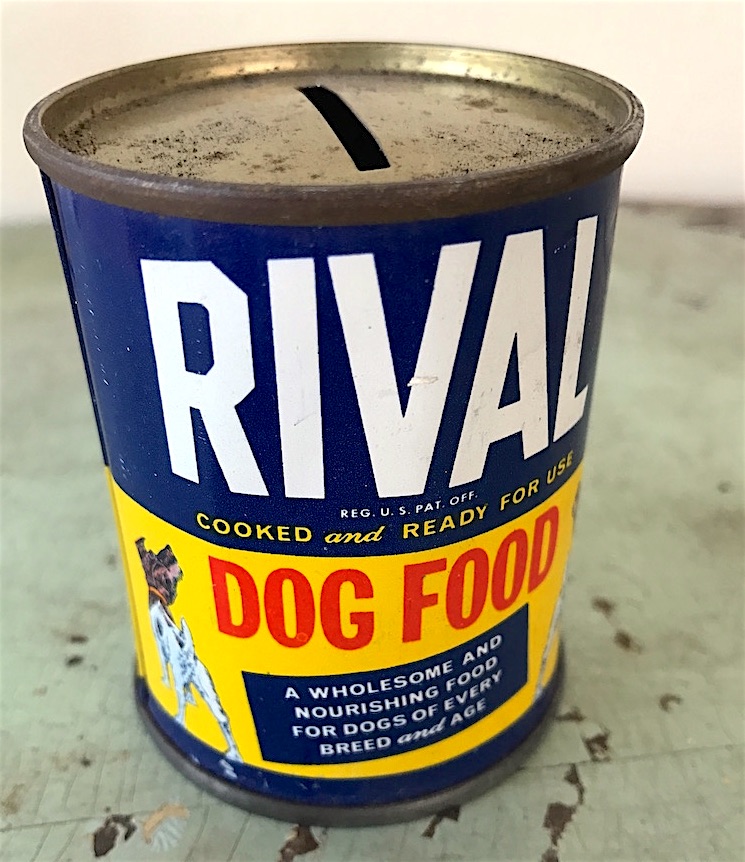
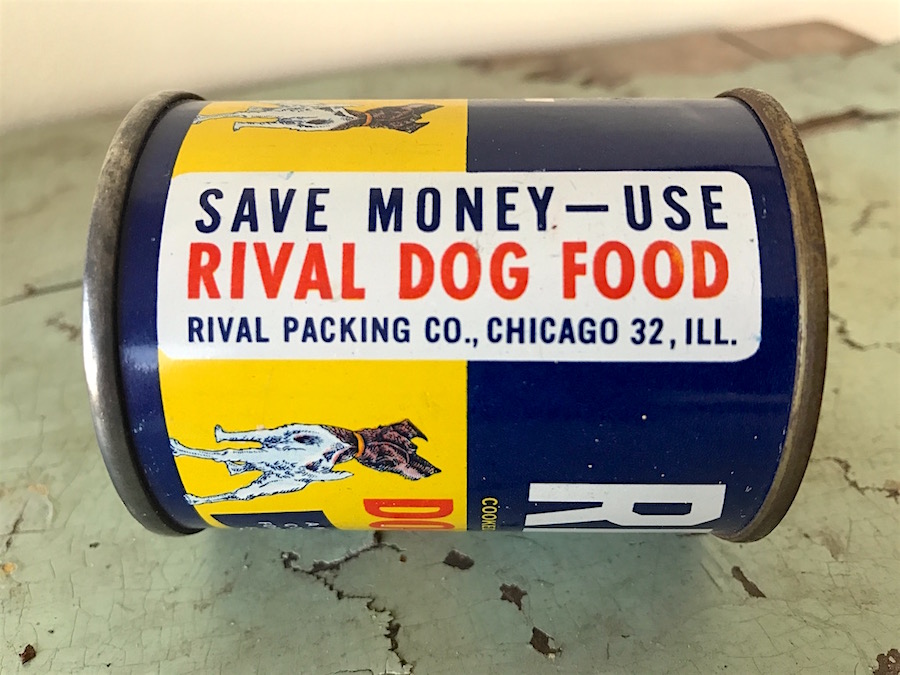
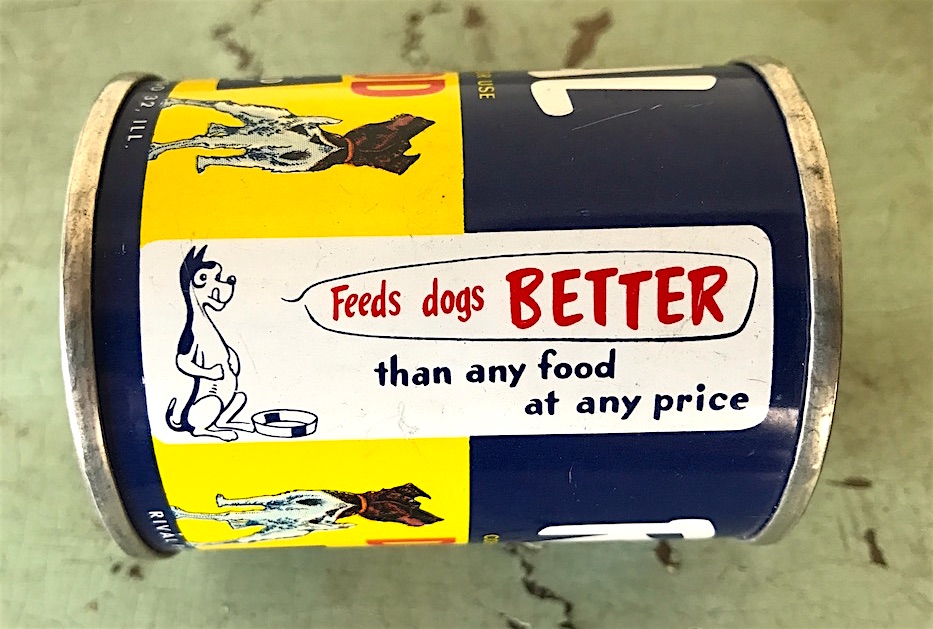
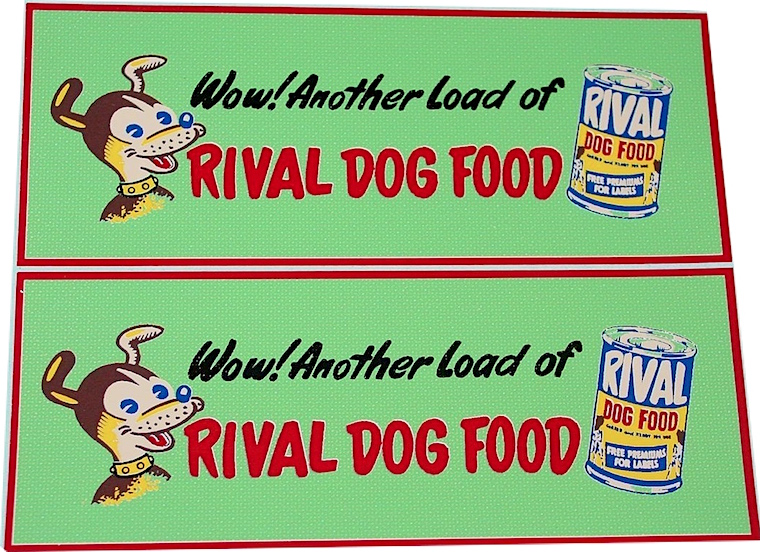
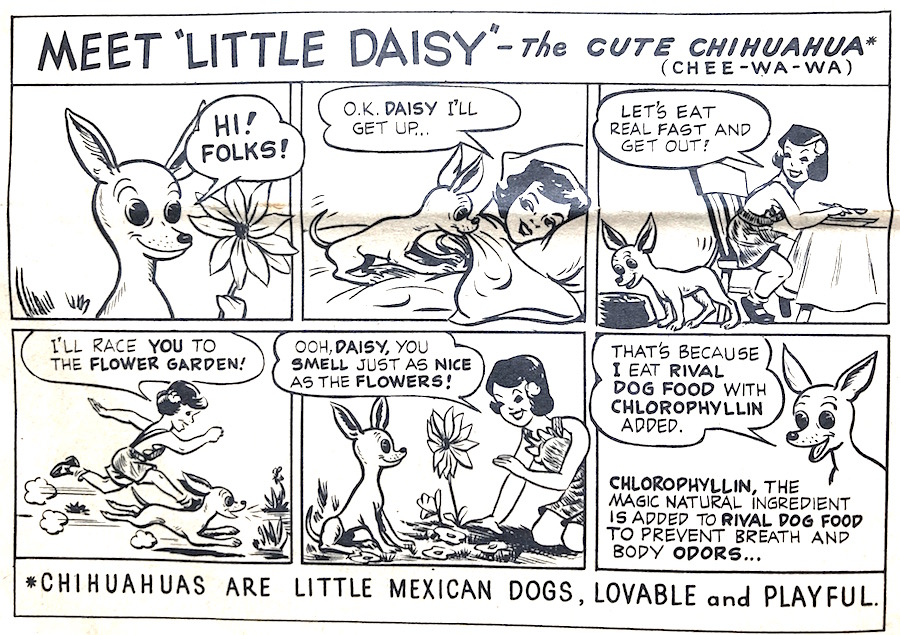
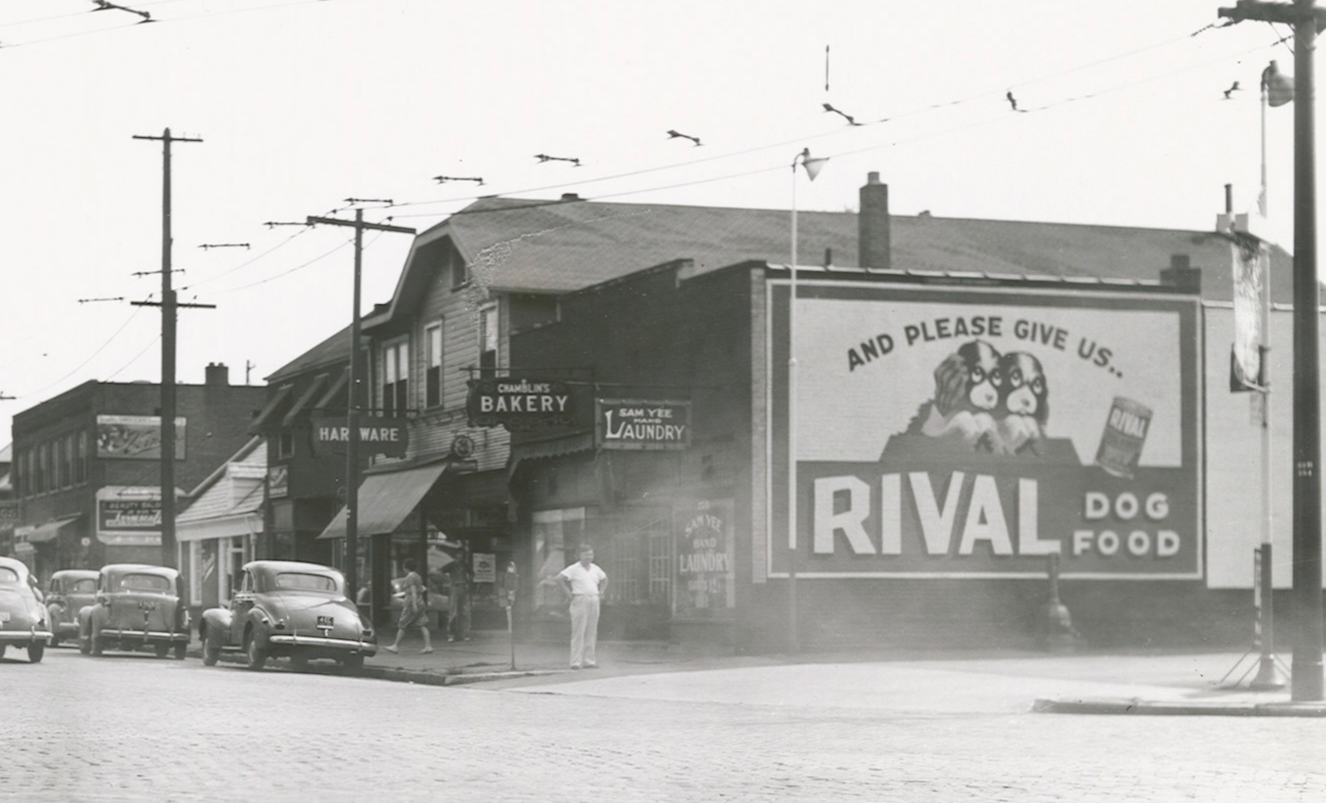 [A Rival ad on the side of a building in Columbus, OH, c. 1940s]
[A Rival ad on the side of a building in Columbus, OH, c. 1940s]
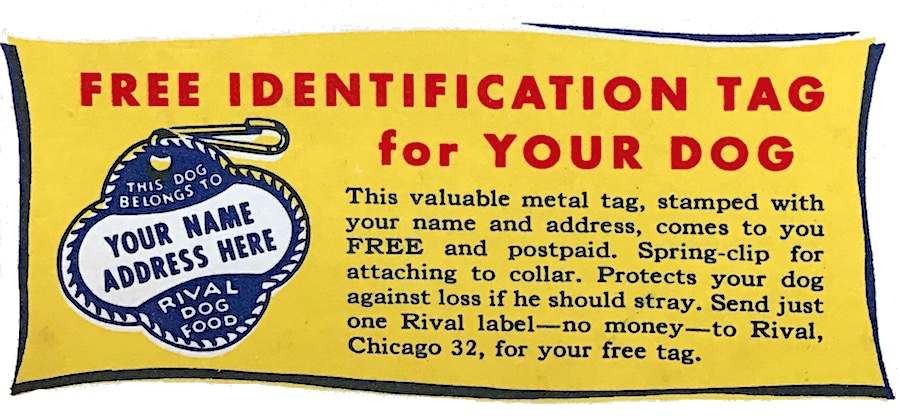
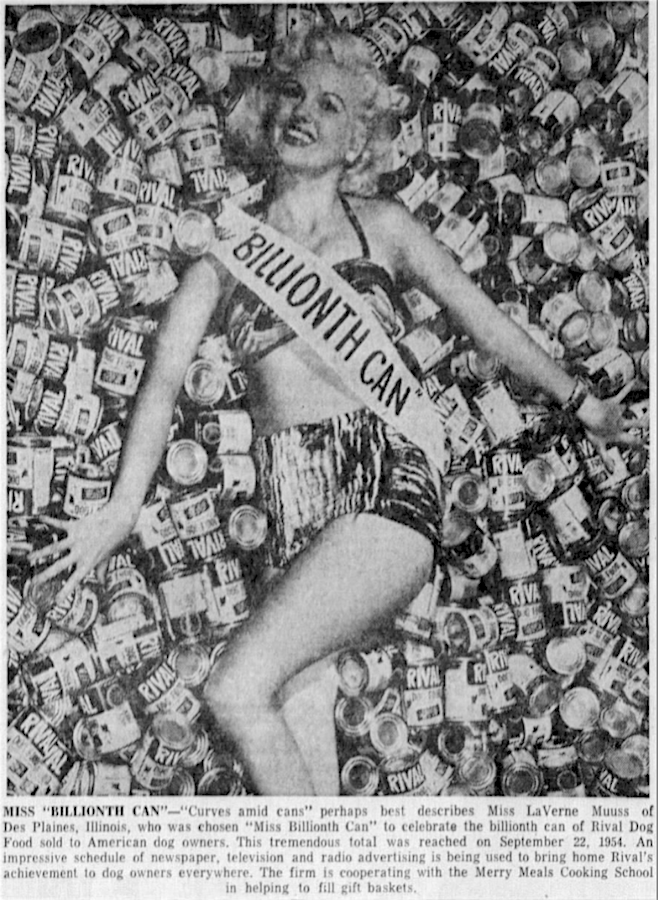
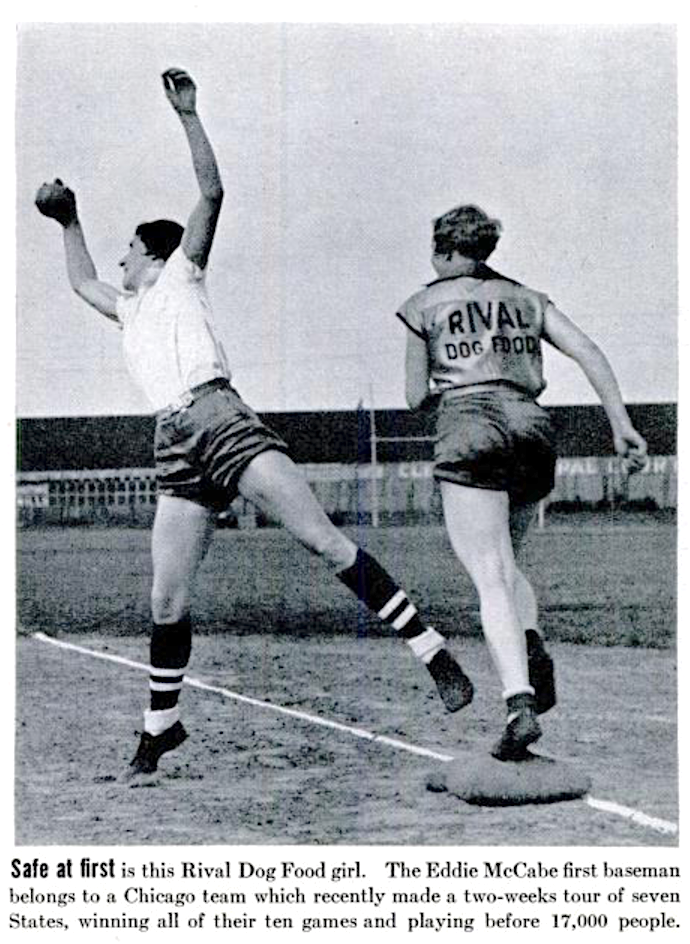
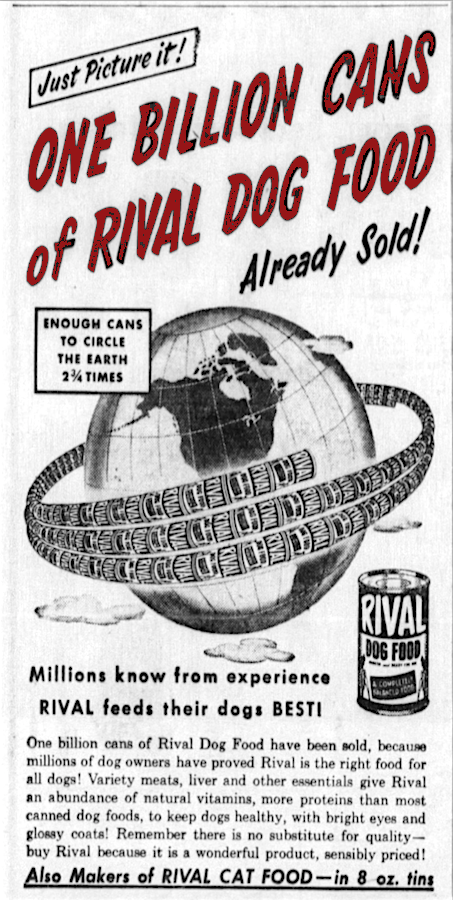
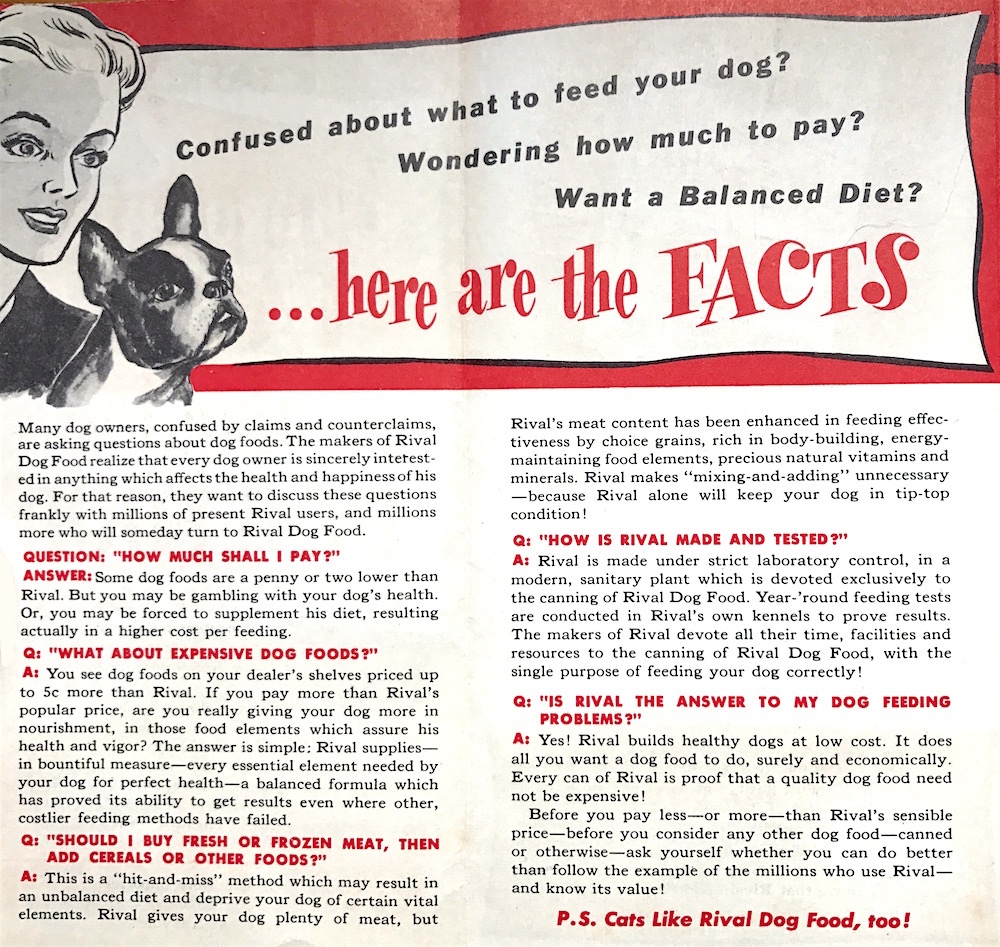
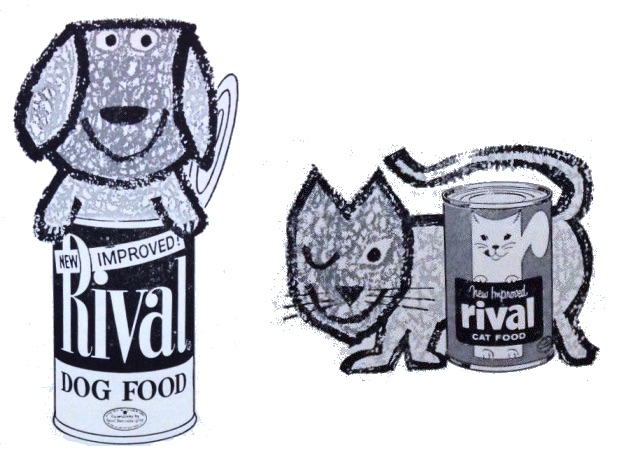
SOURCES
Dogs of the World – Rival Dog Food promo booklet, Whitman Publishing 1940
“Pet Foods Once Got Cold Shoulder from Grocers” – Kingsport News, July 10, 1967
“Provisioning Man’s Best Friend: The Early Years of the American Pet Food Industry: 1870-1942,” by Katherine C. Grier
Food Chains: From Farmyard to Shopping Cart, ed. by Warren Belasco and Roger Horowitz
“Savin’ All My Love for You – A Story of Horse Carnage in the US” – CuChullaine O’Reilly, Horsetalk.co.nz
“Commissioner of Internal Revenue v. Katz, 139 F.2d 107 (7th Cir. 1943)”
“Assail Plans to Ban Use of Dog Food Tins” – Chicago Tribune, Nov 6, 1947
Sales Tales, by James Shannon
“Harry Hoffman Dies in Home; Philanthropist” – Chicago Tribune, July 28, 1971
“Start Work This Week on $400,000 Plant for Rival Packing Company” – Chicago Tribune, June 18, 1939
Archived Reader Comments:
“My father Ken Miller who now lives in Garden Grove California is 91 years old and sold rival dog food from a distributor in Terre Haute Indiana called standard brands he drove a truck and delivered the dog food to different places. He said the dogs love that rival dog food they would wolf it down.
 ” —Steve Miller, 2020
” —Steve Miller, 2020
“LaVerne Muuss, the model mentioned in this article, is my grandma’s cousin . . . and last I heard is still alive and kicking!” —Atom Stevens, 2019
“That’s great to know, Atom. Would be interesting to hear what memories she has of being “Miss Billionth Can.” :)” —Made In Chicago Museum
“I will ask my grandma for her contact info this week and reach out to her!  Let me know if there is a good email address for me to send her response to.” —Atom Stevens
Let me know if there is a good email address for me to send her response to.” —Atom Stevens

What a fun read! I got here while researching a dog tag I found while metal detecting in eastern Massachusetts. Your article provided me with all the answers I needed! Incidentally, my tag is made from aluminum instead of brass — perhaps a later model.
Metal Detector Find South Bend, IN
How cool is this: hitting targets with my metal detector along the railroad tracks. Came across a brass tag, which after reading your historical account of Rival Dog Food discovered it was a promotional giveaway item. I’m having a hard time reading the stamping that’s printed on it. I may have to use electrolysis to clean it up enough to read.
I have a Snoopy Dime Bank with Rival on the dog food Dish. I can send you a picture if you want it.
I visited their facility, southwest of Chicago in late 60’s or early 70,s. Viewed product being manufactured with ingredients from bags marked “Bone” and “Blood, etc. Didn’t seem to be fresh after that.
I am racking my brain to remember a Rival ad slogan that appeared on billboards from the early sixties. Something like, “ Dogs Love (Eat?) Rival Dog Food”, accompanied as I recall by a strong portrait of a bold breed like German shepherd or some such.
The reason I remember it is because the line was transformed into an ugly racial slur and graffitied onto a wall in foot-tall letters that could be seen by traffic running down Garfield Boulevard in Chicago during the early 1960s.
Does anyone recall the original Rival slogan from this era?
I have about 15 Rival Dog Food coupons and wonder if they are worth anything
I have a Rival Dog Food Bank and was wondering what year it was.
Looking for a commercial that is was some time in the late 30’s or early 40’s. My grandpa turned 90 today and he was in the commercial. Two dogs. Chows I believe. One of the dogs names was Runt.
Hollo, my name is Arthur Edgerton and I worked at Rival Pet Foods for 15 years,
I would love to have contact with others who worked there
My Dad’s name was Art Aldag and he was VP of Sales for Rival until his retirement in 1958. One evening, when I was about 7-8 years old, he comes home with several records of jiggles the company was thinking of using for advertising. We had an old Victrola player and we all sat around listening and then “voting”. My favorite and the one I recommended was a little Diddy that started out: “Give me Rival Dog food, give me Rival Dog food …” played to the tune of the Blue Danube Waltz. My dad said it was my vote that decided the issue, and everytime I heard the jiggle on radio, I claimed that I was the deciding factor. On fact, I’m sure my vote was the one that made the difference, but my Dad left an impression that stayed with into young adulthood.
The RIVAL DOG FOOD SONG was the First SONG I MEMORIZED in my life as a Child of 7 years old from the radio. But the recording they played on the radio was a shortened version of the one in this recording here and it had a very upbeat music and singing. “Give him Rival Dog Food, Arf! Arf! Arf! Arf! Give him Rival Dog Food. Arf! Arf! Arf! Arf! Your dog’s Eyes will Shine. Coat look Fine. Give him Rival. Rival. Rival! DOG FOOD!”
It is funny… When I 1st heard the Blue Danube played by an orchestra on the radio…I said excitedly, “OH! MOM! Listen. IT’S THE RIVAL DOG FOOD SONG!” She corrected me but I still believe it is THE RIVAL DOG FOOD SONG! And…I am 73 years Old. LOL
I guess that was the start of me being Comical and busting my Late Wife’s Chops. But we had a Very Humorous & Fun Marriage. So much so a Comedian wants to put me on stage. Just waiting to hear from his Agent. My Wife was jealous of my dog to the point she would growl at him. Funny Story there.
Thank You RIVAL for making me the DOG (Man) I am today.
Even ate MILKBONE in the AIR FORCE.
Fondest Memories to All RIVAL DOG FOOD JINGLE LOVERS & their Pets.
Little Eddy R.
Bristol. Connecticut
USAF Retired. DAV
I have a Rival dog food bank, does the museum want it?
What can anyone tell me about a green ceramic dog dish with a rival stamp on bottom and dogs in grass around the bowl
My father (who passed away 50 years ago) always talked about RIVAL DOG food and told us, as mentioned, that it was only a dime a
Can. The article brings back lots of memories but in atone way seems like out of another world when I think about it today.
Looking for an old rival commercial with a dog named Kelly filmed in Madison Wisconsin. My grandmother was in it.
First off I want to compliment you on your very excellent report, this article is just outstanding my hats off to you sir. Secondly I’m 82 years old and I do remember what it tasted like. My little dog was more of a brother to me than a pet and he wasn’t about to eat anything I didn’t approve of. With that said however, it certainly didn’t replace the human food my mother offered me. In closing, I just want to express again my gratitude for an article exquisitely done. Thank you!